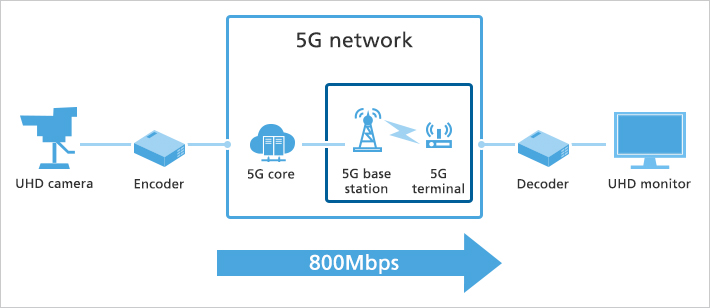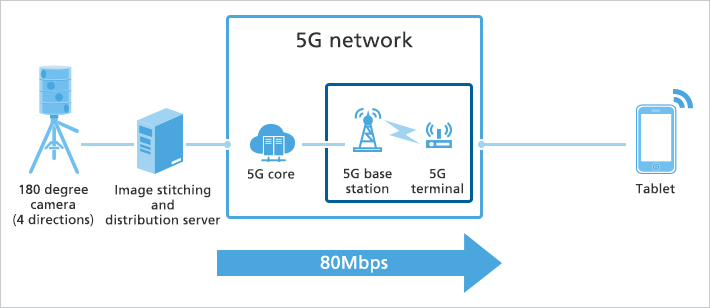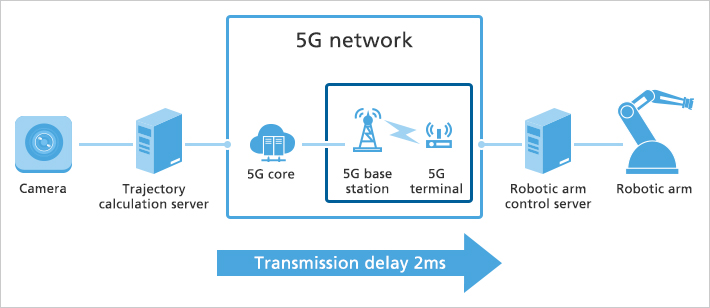SoftBank and Huawei Demonstrate 5G Use Cases
September 8, 2017
SoftBank Corp.
Huawei Technologies Japan K.K.
SoftBank Corp. (“SoftBank”) and Huawei Technologies Japan K.K. (“Huawei”) jointly demonstrated various potential use cases for a 5G network, which provides ultra-high throughput, ultra-low latency transmission, and edge computing, to SoftBank's business partners.
The demonstration included real-time UHD video transmission using ultra-high throughput, remote control of a robotic arm using ultra-low latency transmission and remote rendering via a GPU server using edge computing. The real-time UHD video transmission demonstrated throughput of over 800 Mbps. Also, the remote control of the robotic arm demonstrated an ultra-low latency one-way transmission of less than 2ms.
SoftBank is planning various experiments to study 5G technologies and is endeavoring to launch 5G commercial services around 2020.
- [Note]
-
- *In edge computing, servers are located near by base stations, i.e. at the edge of an mobile network, with a distributed way. This architecture allows us to realize ultra low latency transmission between the servers and mobile terminals. Also, it is possible to process a huge amount of data gathered by IoT devices to decrease the load of the mobile network.
- *
Demonstration details
1. Real-time UHD video transmission
A UHD camera was installed inside the demonstration room to capture outdoor scenery. The data from this camera was then compressed in real-time using an encoder and transmitted through the ultra-high throughput 5G network to a UHD monitor via a decoder, where the original data was recovered. In this demonstration, the scenery of the Odaiba Tokyo Bay area was successfully displayed on the UHD monitor using the ultra-high throughput provided by the 5G network. This technology can be applied to various industries, including tele-health or tele-education.

2. Immersive video
Scenery was captured by a 180-degree camera equipped with four lenses pointing four different directions installed in the demonstration room, and captured scenery was distributed to smartphones and tablets over the 5G network. Four separate cameras were set up to capture the scenery in different directions, and the video images captured by these cameras were stitched together to generate a 180-degree panoramic video image that enabled multiple simultaneous camera views. Then the video image was compressed and distributed to smartphones or tablets in real-time over the 5G network, which gives users a truly realistic user experience. Coupled with a 5G network, this technology can be applied to virtual reality (VR) or augmented reality (AR).

3. Remote control of robotic arm with ultra-low latency
A robotic arm played an air hockey game against a human in this demonstration. A camera installed on top of the air hockey table detected the puck's position to calculate its trajectory. The calculated result was then forwarded to the robotic arm control server to control the robotic arm. In this demonstration, the robotic arm was able to strike back the puck shot by the human player on various trajectories. This technology can be applied to factory automation, for example.

4. Remote rendering by GPU server
Rendering is a technology used to generate videos or images using computers with GPUs (Graphic Processor Unit). This technology is used for generating HD videos in computer games or for CAD (Computer Aided Design). The rendering consumes a large amount of computing resources. Therefore, HD computer games or HD CADs were not executable on tablets or smartphones on their own. However, edge computing technology provided by the 5G network allows us to enjoy HD computer games or HD CADs on tablets or smartphones. A GPU server located near a 5G base station performed rendering and the image generated by the GPU server was sent to the tablet over the ultra-high throughput and ultra-low latency 5G network. This technology can be applied to check the CAD data at a construction site with a tablet or to enjoy a HD game application on a smartphone.

- [Notes]
-
- *“Immersive video” and “remote control of a robotic arm with ultra-low latency” were jointly integrated and configured for demonstration by SoftBank and Huawei. “UHD real-time video transmission” and “Remote rendering with GPU servers” were integrated and configured for demonstration by SoftBank.
- *
- SoftBank, its name and logos are trademarks or registered trademarks of the companies in the SoftBank Group in Japan or other countries.
- All other company and product or services names in this press release may be trademarks of the respective companies with which they are associated.
- The information is true and accurate at the time of publication.
Price, specification, contact and other information of products and service may be subjected to change. The information contains certain forward-looking statements that are subject to known and unknown risks and uncertainties that could cause actual results to differ materially from those expressed or implied by such statements.